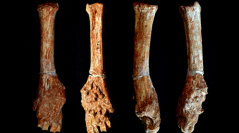

 Comptes Rendus Palevol
15 (1-2) - Pages 245-254
Comptes Rendus Palevol
15 (1-2) - Pages 245-254Islands have been regarded by scientists as a living laboratory of evolution, and a prime target for the study of forces influencing evolution. This research aims to investigate whether a dwarf deer (Candiacervus ropalophorus), that suffered a traumatic fracture of its metatarsal, might have survived, despite the broken limb, in the Cretan free-predator environment for a time longer than commonly expected on mainland. The metatarsal shows a healed complete and oblique fracture at level of the distal part of the diaphysis. Both macroscopic and X-ray examinations show the impressive new bone formation that occurred in the post-trauma period. The size of osseous callus, covering the fracture line and the surface next to the lesion, suggests that the deer has survived several months after the traumatic injury. In a mainland context, an injured deer would hardly have survived for such a long period, because any movement constantly irritated the fracture, dramatically reducing performance or willingness to move and the gait speed, and hampering any escape.
Candiacervus, Dwarf deer, Bone fracture, Crete, Pleistocene